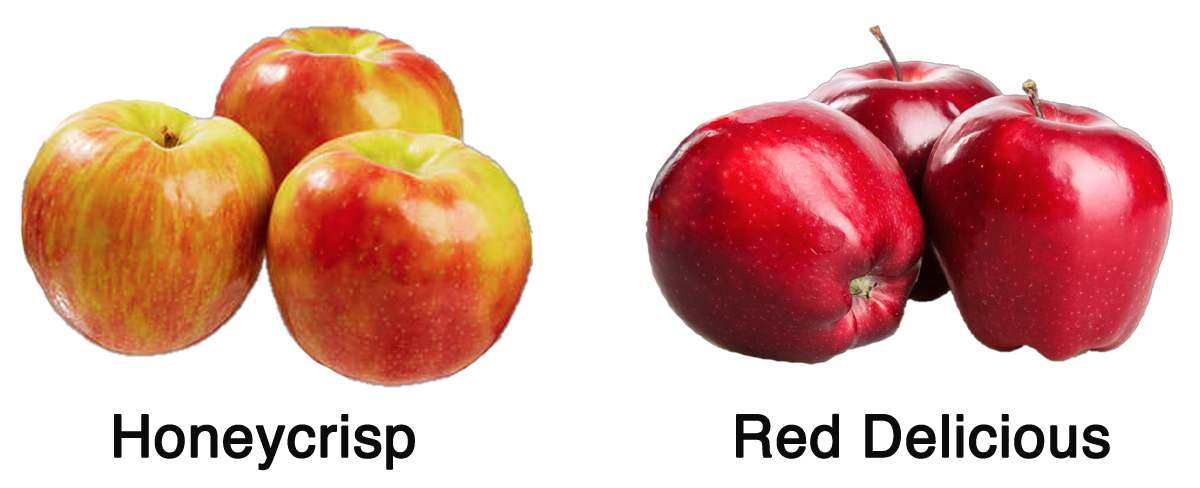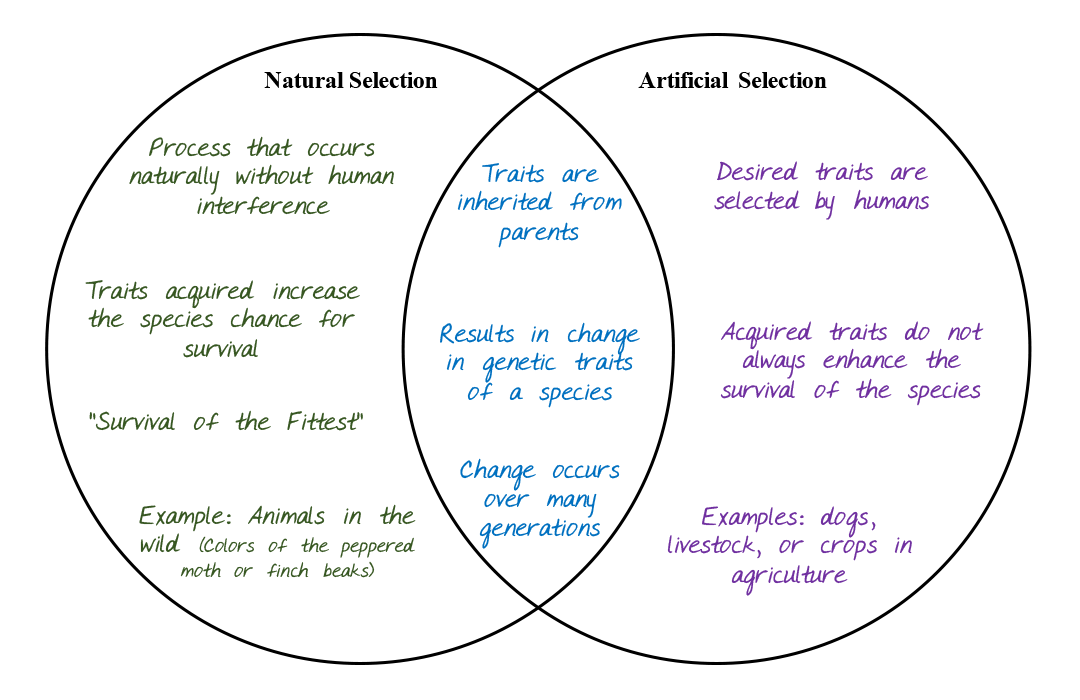Apples and the Science of Genetic Selection
Students will distinguish between natural and artificial selection and use a student-centered learning activity to see how science and genetics have been used to artificially select apples for specific traits like color, texture, taste, and crispness.
Background
Lesson Activities
Recommended Companion Resources
Credits
Author
Harley Braun, Sue Knott, Keri Sidle | Minnesota Agriculture in the Classroom
Sources
- http://usapple.org/all-about-apples/apple-varieties/
- https://www.farmflavor.com/at-home/cooking/10-fun-facts-about-apples/
University of Minnesota Apple Breeding: https://mnhardy.umn.edu/varieties/fruit/apples/all-apple-varieties
Standards
Texas Content Area Standards
-
Principles of Agriculture, Food, and Natural Resources: 130.2.c.1
The student demonstrates professional standards/employability skills as required by business and industry. The student is expected to:
- Principles of Agriculture, Food, and Natural Resources: 130.2.c.1.B: apply competencies related to resources, information, interpersonal skills, problem solving, critical thinking, and systems of operation in agriculture, food, and natural resources.
-
Principles of Agriculture, Food, and Natural Resources: 130.2.c.4
The student explains the historical, current, and future significance of the agriculture, food, and natural resources industry. The student is expected to:
- Principles of Agriculture, Food, and Natural Resources: 130.2.c.4.B: analyze the scope of agriculture, food, and natural resources and its effect upon society.
- Principles of Agriculture, Food, and Natural Resources: 130.2.c.4.C: evaluate significant historical and current agriculture, food, and natural resources developments.
-
Principles of Agriculture, Food, and Natural Resources: 130.2.c.6
The student demonstrates appropriate personal and communication skills. The student is expected to:
- Principles of Agriculture, Food, and Natural Resources: 130.2.c.6.A: demonstrate written and oral communication skills appropriate for formal and informal situations such as prepared and extemporaneous presentations.
- Principles of Agriculture, Food, and Natural Resources: 130.2.c.6.B: demonstrate effective listening skills appropriate for formal and informal situations.
-
Principles of Agriculture, Food, and Natural Resources: 130.2.c.11
The student develops technical knowledge and skills related to plant systems. The student is expected to:
- Principles of Agriculture, Food, and Natural Resources: 130.2.c.11.C: describe plant reproduction, genetics, and breeding.
- Principles of Agriculture, Food, and Natural Resources: 130.2.c.11.D: identify plants of importance to agriculture, food, and natural resources
-
English I: 110.36.c.1
Developing and sustaining foundational language skills: listening, speaking, discussion, and thinking--oral language. The student develops oral language through listening, speaking, and discussion.
- English I: 1.A: The student is expected to engage in meaningful and respectful discourse by listening actively, responding appropriately, and adjusting communication to audiences and purposes.
- English I: 1.D: The student is expected to participate collaboratively, building on the ideas of others, contributing relevant information, developing a plan for consensus building, and setting ground rules for decision making.
-
English I: 110.36.c.4
Comprehension skills: listening, speaking, reading, writing, and thinking using multiple texts. The student uses metacognitive skills to both develop and deepen comprehension of increasingly complex texts.
- English I: 4.G: The student is expected to evaluate details read to determine key ideas.
-
English I: 110.36.c.5
Response skills: listening, speaking, reading, writing, and thinking using multiple texts. The student responds to an increasingly challenging variety of sources that are read, heard, or viewed.
- English I: 5.B: The student is expected to write responses that demonstrate understanding of texts, including comparing texts within and across genres.
-
English II: 110.37.c.4
Comprehension skills: listening, speaking, reading, writing, and thinking using multiple texts. The student uses metacognitive skills to both develop and deepen comprehension of increasingly complex texts.
- English II: 4.G: The student is expected to evaluate details read to determine key ideas.
-
English II: 110.37.c.1
Developing and sustaining foundation language skills: listening, speaking, discussion, and thinking--oral language. The student develops oral language through listening, speaking, and discussion.
- English II: 1.A: The student is expected to engage in meaningful and respectful discourse by listening actively, responding appropriately, and adjusting communication to audiences and purposes.
- English II: 1.D: The student is expected to participate collaboratively, building on the ideas of others, contributing relevant information, developing a plan for consensus building, and setting ground rules for decision making.
-
English III: 110.38.c.1
Developing and sustaining foundational language skills: listening, speaking, discussion, and thinking--oral language. The student develops oral language through listening, speaking, and discussion.
- English III: 1.A: The student is expected to engage in meaningful and respectful discourse when evaluating the clarity and coherence of a speaker's message and critiquing the impact of a speaker's use of diction and syntax.
- English III: 1.D: The student is expected to participate collaboratively, offering ideas or judgements that are purposeful in moving the team toward goals, asking relevant and insightful questions, tolerating a range of positions and ambiguity in decision making, and evaluating the work of the group based on agreed-upon criteria.
-
English III: 110.38.c.4
Comprehension skills: listening, speaking, reading, writing, and thinking using multiple texts. The student uses metacognitive skills to both develop and deepen comprehension of increasingly complex texts.
- English III: 4.G: The student is expected to evaluate details read to understand key ideas.
-
English III: 110.38.c.5
Response skills: listening, speaking, reading, writing, and thinking using multiple texts. The student responds to an increasingly challenging variety of sources that are read, heard, or viewed.
- English III: 5.B: The student is expected to write responses that demonstrate analysis of texts, including comparing texts within and across genres.
-
English II: 110.37.c.5
Response skills: listening, speaking, reading, writing, and thinking using multiple texts. The student responds to an increasingly challenging variety of sources that are read, heard, or viewed.
- English II: 5.B: The student is expected to write responses that demonstrate understanding of texts, including comparing texts within and across genres.
-
English IV: 110.39.c.1
Developing and sustaining foundational language skills: listening, speaking, discussion, and thinking--oral language. The student develops oral language through listening, speaking, and discussion.
- English IV: 1.A: The student is expected to engage in meaningful and respectful discourse when evaluating the clarity and coherence of a speaker's message and critiquing the impact of a speaker's use of diction, syntax, and rhetorical strategies.
- English IV: 1.D: The student is expected to participate collaboratively, offering ideas or judgements that are purposeful in moving the team toward goals, asking relevant and insightful questions, tolerating a range of positions and ambiguity in decision making, and evaluating the work of the group based on agreed-upon criteria.
-
English IV: 110.39.c.4
Comprehension skills: listening, speaking, reading, writing, and thinking using multiple texts. The student uses metacognitive skills to both develop and deepen comprehension of increasingly complex texts.
- English IV: 4.G: The student is expected to evaluate details read to analyze key ideas.
-
English IV: 110.39.c.5
Response skills: listening, speaking, reading, writing, and thinking using multiple texts. The student responds to an increasingly challenging variety of sources that are read, heard, or viewed.
- English IV: 5.B: The student is expected to write responses that demonstrate analysis of texts, including comparing texts within and across genres.
-
English I: 110.36.c.3
Developing and sustaining foundational language skills: listening, speaking, reading, writing, and thinking--self-sustained reading. The student reads grade-appropriate texts independently.
- English I: 3: The student is expected to self-select text and read independently for a sustained period of time.
-
English II: 110.37.c.3
Developing and sustaining foundational language skills: listening, speaking, reading, writing, and thinking--self-sustained reading. The student reads grade-appropriate texts independently.
- English II: 3: The student is expected to self-select text and read independently for a sustained period of time.
-
English III: 110.38.c.3
Developing and sustaining foundational language skills: listening, speaking, reading, writing, and thinking--self-sustained reading. The student reads grade-appropriate texts independently.
- English III: 3: The student is expected to self-select text and read independently for a sustained period of time.
-
English IV: 110.39.c.3
Developing and sustaining foundational language skills: listening, speaking, reading, writing, and thinking--self-sustained reading. The student reads appropriate texts independently.
- English IV: 3: The student is expected to self-select text and read independently for a sustained period of time.
-
Biology: 112.34.c.7
Science concepts. The student knows evolutionary theory is a scientific explanation for the unity and diversity of life.
- Biology: 7.E: The student is expected to analyze and evaluate the relationship of natural selection to adaptation and to the development of diversity in and among species.
-
Integrated Physics and Chemistry: 112.38.c.6
Science concepts. The student knows that relationships exist between the structure and properties of matter.
- Integrated Physics and Chemistry: 6.A: The student is expected to examine differences in physical properties of solids, liquids, and gases as explained by the arrangement and motion of atoms or molecules.
-
Food Technology and Safety: 130.15.c.3
The student explains the impact of food science systems. The student is expected to:
- Food Technology and Safety: 130.15.c.3.A: explain the significance of food science systems.
- Food Technology and Safety: 130.15.c.3.B: define trends in food production, world population, and supply and demand for food products.
-
Food Technology and Safety: 130.15.c.10
The student describes the processing, packaging, quality analysis, and marketing of fruits, nuts, and vegetables and their by-products. The student is expected to:
- Food Technology and Safety: 130.15.c.10.A: identify, classify, and grade fruits, nuts, and vegetables.
-
Horticultural Science: 130.23.c.3
The student develops technical skills associated with the management and production of horticultural plants. The student is expected to:
- Horticultural Science: 130.23.c.3.F: describe the processes of fruit, nut, and vegetable production.
-
Biology: 112.42.c.10
Science concepts--biological evolution. The student knows evolutionary theory is a scientific explanation for the unity and diversity of life that has multiple mechanisms. The student is expected to:
- Biology: 112.42.c.10.C: analyze and evaluate how natural selection may lead to speciation
-
Integrated Physics and Chemistry: 112.44.c.7
Science concepts. The student knows that relationships exist between the structure and properties of matter. The student is expected to:
- Integrated Physics and Chemistry: 112.44.c.7.A: model basic atomic structure and relate an element's atomic structure to its bonding, reactivity, and placement on the Periodic Table

